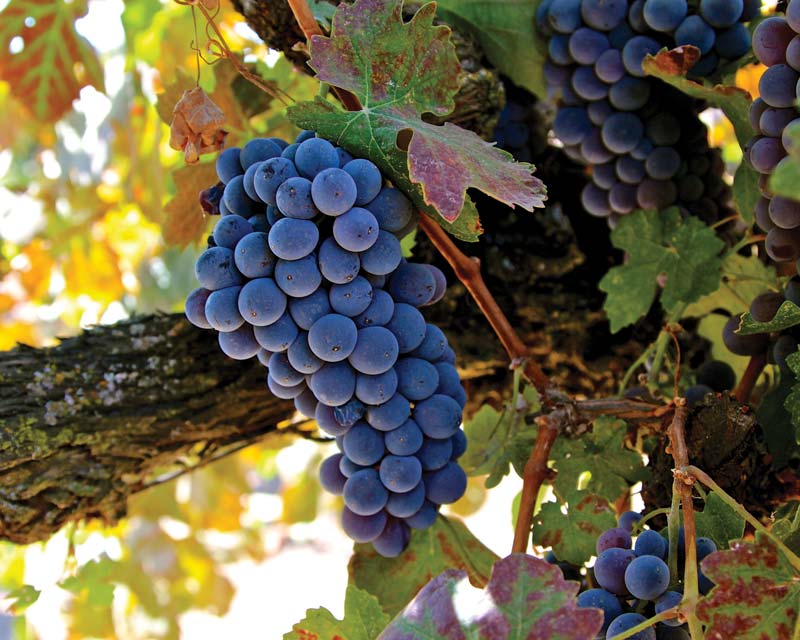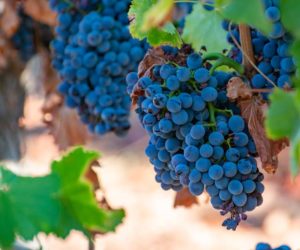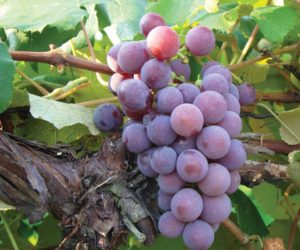A grape to be grateful for
In the far north-central part of Spain, at the foot of the Cantabrian Mountains, are the beginnings of the Ebro River Valley. Wine lovers are most often familiar with the region known as the Rioja, known for the waters (Rio Oja) that flow from the mountain range towards the Ebro River. The history of wine in this region dates back to the Phoenicians around 1000 BCE. The Phoenicians are credited to spreading viticulture and winemaking throughout the Mediterranean region from what is known as modern-day Lebanon.
The Rioja wine region has a rich history and was the first in Spain to hold the distinction of the highest category in the country’s wine regulation, the D.O.Ca., or more familiarly, Qualified Designation of Origin. (denominación de origen calificada). Three regions within the Rioja exist: Rioja Alta, Rioja Oriental, and Rioja Alavesa. Historically wines from Rioja have been blended across all three regions, but there is now somewhat of a movement to create some individual regional identity. While Tempranillo is the predominant grape variety in the region, Graciano is emerging as a varietal of importance and is seeing increasing interest from other parts of the world as well. California and Australia are at the top of that list and both have Graciano in their annual reports.
Graciano’s Background
Graciano is a red grape known for its tannic and acidic nature. Like Petit Verdot, it is better known as a great blending grape and is heralded as building structure in the Gran Reservas of Rioja alongside Tempranillo and Garnacha. But increasingly it is being made into varietal wines. The adjacent wine region of Navarra is also known for its plantings of this variety.

Vines of Graciano seemed to be introduced to the Rioja region in the 19th century and due to its prevalence around the Iberian Peninsula and the Mediterranean it is not surprising it has many synonyms. French ampelographers Pierre Galet and Paul Truel grouped it to be the same as Bovale Sardo and Cagnuli, both found on Sardinia, and that claim has since been confirmed via DNA analysis. With DNA studies in the picture it was also established there was some relationships to Monastrell (Mourvèdre) and Mazuelo (Carignane). In these studies, especially with grapes, results of these analyses can be suggestive of relationships.
Like Petit Verdot, it is better known as a great blending grape and is heralded as building structure in the Gran Reservas of Rioja alongside Tempranillo and Garnacha.
In one study, Graciano and Mazuelo were deemed to have a parent-offspring relationship and Graciano and Monastrell could be siblings. But other studies disprove any of these. Clearly, this is a situation where New World science cannot fully unravel the Old World grape history. Further confusion seemingly lies in the use of similarly spelled synonyms across the region. From a homophones perspective, Monastrell is often confused with Moristell and Moristell is identical to Graciano. My head hurts now.
In the Vineyard
In the vineyard it is late budding and late ripening. Late budding helps reduce its susceptibility to spring frost. It is a vigorous, drought-resistant variety. Low fertility of the flowers leads to low yields. It is susceptible to the usual downy mildew and rot. It likes hot climates in order to achieve full ripeness, one reason the Rioja is a great region for this variety.
Plantings in Spain were more widespread before phylloxera struck at the end of the 19th century. Vineyard area in Spain was reported at 1,478 Ha (3,650 acres) in 2008 and that area has stayed more or less consistent since then. The low yields make it a less desirable variety to grow, but increased interest in its role as a variety is leading to some increased plantings. The DOCa is recognizing it in its role as a varietal as a movement toward encouraging regional microclimates and greater focus on single vineyard sites.
In the Winery
As noted earlier, the fruit is known for its acidity, which comes into play when incorporated into the blends of the Rioja region. Aside from its emergence as a varietal wine, it is also made into red and rosé styles as part of a blend. It is typically blended with Tempranillo, Garnacha Tinta, Mazuelo, and Maturana Tinta varieties.
Graciano is robust when it comes to tannins, thus it needs to be aged for some time. At a tasting of Spanish wines in San Francisco a few years ago, I found that there was a very large percentage of the wines aged in American oak. With the very small volumes I was working with at UC-Davis, oak aging was a challenge to say the least.
In the Rioja, the Crianza classification requires the red versions of Graciano spend one year in the barrel. For Reserva, the wines must be aged for a minimum of three years, in any combination of barrel and bottle, as long as it spends a minimum of one year in the barrel. For Gran Reserva, a minimum of two years in the barrel, and bottle aged for at least three years.
These classifications consider what it takes to earn the DOCa classification. The wines take time to develop. Barrel aging is a necessary step when working with Graciano, or any other wine that is very tannic, presenting itself as very astringent. When wine is barrel aging, those small volumes of wine used for topping up introduce a small quantity of oxygen. This is a process known as micro-oxygenation, or MOX for short. Over time the astringency will begin to soften, preparing the wine for the next phase in the bottle. Bottling too early will essentially hold the astringency for much longer. Track the wine’s taste profile over time if you follow the barrel route. Rioja has its minimum period of barrel aging for DOCa classification, but sometimes I find it’s more a case of the wine letting you know when it is ready. In reality, for most of us obtaining enough wine to make a barrel, and having enough to top up the barrel at least monthly over the aging process, is probably the biggest challenge.
Since most volumes are small from a home winemaker perspective, I feel like I can offer you a micro-representation of working to make your Graciano wine world class. At UC-Davis there were 14 vines of Graciano at the university’s demonstration vineyard early on in my career. This allowed me to work with it for a couple of seasons. They produced about fifteen pounds (6.8 kg) of fruit per vine. We did a standard crush and de-stem using a small Zambelli crusher/destemmer. This was the only equipment we had. This process was very destructive to the berries, crushing both the stems and berries. In retrospect, destemming with minimal berry damage would have been our next best option. This opinion was based on how the finished wines tasted.
Post crushing and destemming, we transferred the must to tall, narrow, food-grade plastic fermenters and after a 50 mg/L (ppm) sulfur dioxide addition and 24-hour soak, we inoculated with yeast and proceeded with the fermentation. Punchdowns were conducted 2–3 times daily to distribute the heat from the cap. The configuration of these containers allowed for cap temperatures to reach 90 °F (32 °C), which in the end probably improved the color as compared to previous vintages. However, the wine was very astringent. After pressing, we transferred the wine to stainless steel kegs. Since kegs do not breathe, we mimicked the MOX process by racking the wine at two-month intervals.
During each racking cycle, we checked and adjusted sulfur dioxide to around 35 mg/L (ppm). For one two-month cycle we added oak cubes, removing them at the next racking cycle. Over time the astringency was reduced, but not the same had the wine been able to age in the barrel. The academic year required us to move on and use this wine as a teaching tool. I think the key to making this wine more complete was to keep up the 2-month racking regimen. Also critical to keeping small volumes of wine around is the use of stainless steel kegs, checking sulfur dioxide regularly, and keeping them completely topped up to prevent surface films and premature macro-oxidation.
With limited plantings of Graciano domestically it may take a few years to actually get your hands on some fruit. But more importantly, you can research the local bottle shop and ask for the wine by name, or research and see how much has been included in the Rioja wines they carry. And for those that do have access, it’s a fun wine to play with and if you struggle taming those tannins, it’s time for a big juicy steak or hamburger to pair along with it.
Graciano Recipe
Ingredients
- 125 pounds (57 kg) fresh Graciano fruit
- Distilled water
- 10% potassium metabisulfite (KMBS) solution (Weigh 10 grams of KMBS, dissolve into about 50 milliliters (mL) of chlorine free water. When completely dissolved, make up to 100 mL total with distilled water.)
- 5 g Enoferm Syrah yeast
- 5 g Diammonium phosphate (DAP)
- 5 g Go-Ferm
- 5 g Fermaid K (or equivalent yeast nutrient)
- Malolactic fermentation starter culture (CHR Hansen or equivalent)
Equipment
- 15-gallon (57-L) food-grade plastic bucket for fermentation
- 5-gallon (19-L) carboy
- (1–2) one-gallon (3.8-L) jugs
- Racking hoses
- Destemmer/crusher
- Wine press
- Inert gas (nitrogen, argon, or carbon dioxide)
- Ability to maintain a fermentation temperature of 81–86 °F (27–30 °C)
- Thermometer capable of measuring between 40–110 °F (4–43 °C) in one degree increments
- Pipettes with the ability to add in increments of 1 mL
Step by Step
- Crush and destem the grapes. Transfer the must to your fermenter.
- During the transfer, add 15 milliliters of 10% KMBS solution (This addition is the equivalent of 50 ppm SO₂). Mix well.
- Take a sample to test for Brix, acidity, and pH. Keep the results handy. We’ll take this up later.
- Layer the headspace with inert gas and keep covered. Keep in a cool place overnight.
- The next day sprinkle the Fermaid K directly to the must and mix well.
- Go back to those lab results you took yesterday. Typical Brix for this style is 24-25 °B. Typical pre-fermentation acid levels will be 5.0 to 7.0 g/L. Adjust as necessary using tartaric acid to pre-fermentation level of 7.5 to 8.0 g/L. Don’t worry here; the malolactic conversion will drop the acid levels. We’ll measure later after fermentation. Slightly higher acid won’t hurt here.
- Prepare yeast. Heat about 50 mL chlorine-free water to 108 °F (42 °C). Mix the Go-Ferm into the water to make a suspension. Take the temperature. Pitch the yeast when the suspension is 104 °F (40 °C). Sprinkle the yeast on the surface and gently mix so that no clumps exist. Let sit for 15 minutes undisturbed. Measure the temperature of the yeast suspension. Measure the temperature of the must. You do not want to add the yeast to your cool juice if the temperature of the yeast and the must temperature difference exceeds 15 °F (8 °C). To avoid temperature shock, you should acclimate your yeast by taking about 10 mL of the must juice and adding it to the yeast suspension. Wait 15 minutes and measure the temperature again. Do this until you are within the specified temperature range.
- You should see signs of fermentation within about one to two days.
- You need have on hand the ability to push the grapes back into the juice to promote color. This is called “punching down” and this should be done two to three times per day. Use a clean utensil or your hand to mix.
- Monitor the Brix and temperature twice daily during peak fermentation (10–21 °Brix). Morning and evening is best and more often if the temperature shows any indication of exceeding 86 °F (30 °C), in which case place frozen water bottles into the fermentation. Mix the must. Wait 15 minutes, mix and check the temperature again. Do this as often as it takes to keep the temperature between 81–86 °F (27–30 °C). Do not cool off to less than 81 °F (27 °C).
- At about 19 °Brix, sprinkle in the DAP and punchdown.
- When the Brix reaches zero (about 5–7 days), transfer the must to your press and press the cake dry. Keep the free run wine separate from the press portion for now. Your press fraction may only be a gallon or two (3.8–7.6 L) so use the smaller jugs. Make sure you do not have any headspace.
- Inoculate with your malolactic (ML) bacteria. Check the manufacturer’s instruction on how to prepare and inoculate. Cover the tops with an airlock to allow CO2 to escape.
- Monitor the ML fermentation using a thin layer chromatography assay available from most home winemaking supply stores. Follow the instructions included in the kit.
- When the MLF is complete, measure the residual sugar through tasting or by sending a sample to a lab.
- Add 2 mL of fresh KMBS (10%) solution per gallon (3.8 L) of wine. This is the equivalent to ~40 ppm addition.
- Measure the pH and titratable acidity. Most importantly you want a finished TA of about 6.5 g/L. The pH is secondary but should be around 3.7. Consider adding acid to adjust the TA prior to settling, but taste the wine first to make sure it is not too tart. Do not add any more acid if the wine is already tart.
- Place wine in a cool spot to settle.
- After two weeks, test for SO₂, adjust the SO₂ as necessary to attain 0.8 ppm molecular SO₂. (There is a simple SO₂ calculator at winemakermag.com/sulfitecalculator). Check the SO₂ in another two weeks and adjust. Once the free SO₂ is adjusted, maintain at this level. You’ll just need to check every two months or so and before racking.
- Rack the wine three times over a 10-month period. Consider using some oak cubes or staves to add some oak flavors. Follow the manufacturer’s guidelines for dosage rate and contact time. Time around your racking cycles.
- Fining and/or filtration are generally not needed if SO₂ are maintained and there are no surface films or indications of subsequent fermentations. Consult Winemakermag.com for tips on fining and filtration if problems are evident.
- Once the wine has cleared it is time to move it to the bottle. Make the project fun by having a blending party to integrate the press fraction back into the free run. Given the tannic nature of Graciano it may not need it at all.
- Maintain sanitary conditions while bottling. Once bottled, you’ll need to periodically check your work by opening a bottle to enjoy with friends.







